Key Takeaways
- Implementing engaging activities such as threading beads, playing with building blocks, and arts and crafts can enhance fine motor skills.
- Early identification of developmental delays and introduction of targeted occupational therapy interventions can promote skill development.
- Home-based activities like sensory play, drawing open circles for sticker placement, and structured play can strengthen hand muscles and improve hand-eye coordination.
- Activities encouraging reaching, grasping, and exposure to different textures can foster skill development in infants and toddlers.
- Tailored strategies focusing on the child’s unique strengths and areas of improvement can boost self-reliance, self-confidence, and autonomy in performing daily tasks.
Understanding Stages of Development
Many daily tasks rely on fine motor abilities, which involve the intricate coordination of small hand muscles. Mastering these skills is fundamental to fine motor development, especially in children with developmental delays. This population often experiences challenges executing tasks such as writing, drawing, or buttoning clothes, which most of us take for granted. These skills also play a vital role in the child’s self-care tasks and can positively impact classroom activities.
Fine motor skills are essential for daily independence and academic success. Children’s ability to navigate the classroom environment, utilizing tools like pencils, scissors, and computers, mainly depends on the development and efficiency of these small muscles. A deficiency in these skills can lead to academic setbacks, making early identification and intervention crucial.
Occupational therapists play a pivotal role in addressing these issues. They can assist children struggling with fine motor skills through tailored interventions, fostering their ability to participate fully in school and everyday life. In this way, they contribute profoundly to the overall growth and well-being of children with developmental delays.
Importance of Skill Development
Moving from understanding fine motor skills, let’s focus on the significance of skill development in children with developmental delays, including autism. Developing fine motor skills, which a child uses in daily activities, is essential for their independence and quality of life. These skills improve hand-eye coordination, finger dexterity, and grip strength, making them foundational for writing, drawing, cutting with scissors, and buttoning clothes. Play-based activities and targeted exercises are often utilized in this developmental growth.
When children with developmental delays develop fine motor skills, they can perform tasks like self-care, writing, and tool usage more efficiently. The following points can highlight the importance of improving these skills:
- Improvement in daily functioning as the child becomes skilled at performing tasks independently.
- Enhanced academic performance as skills such as writing and tool manipulation improve.
- Better social interactions as the child gains confidence from their increased abilities.
- Potential for targeted interventions, such as occupational therapy, to boost significantly skill development.
- The ability for specific activities to help children progress in their fine motor skill development.
Home Activities for Improvement
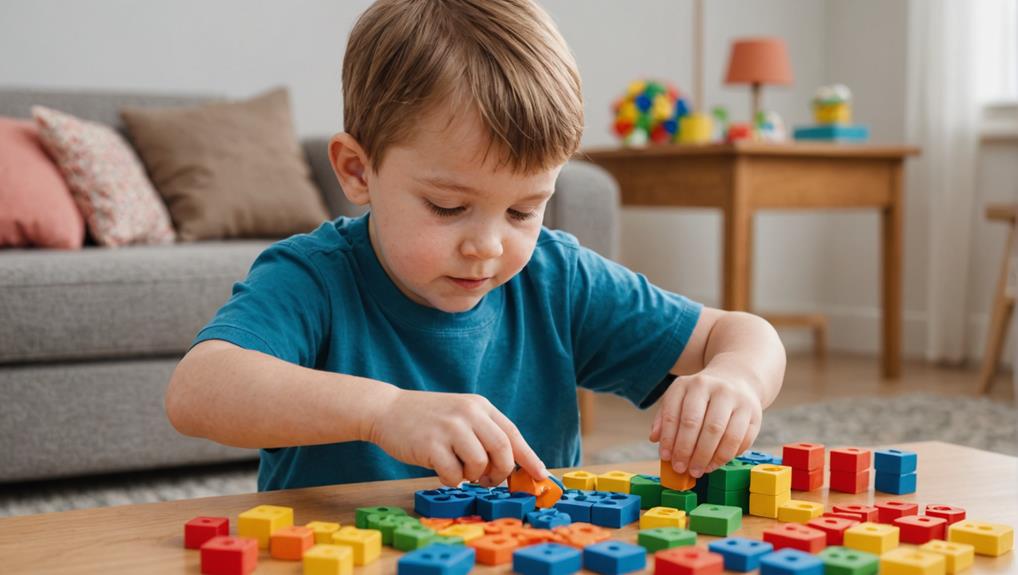
Children with developmental delays can significantly improve their fine motor skills through various engaging activities in the comfort of their homes. Simple yet effective tasks like threading beads, buttoning clothes, and playing with building blocks can enhance their agility and coordination, effectively aiding their overall development.
Incorporating innovative problem-solving through structured play activities at home can further increase their fine motor skills. For instance, building structures with blocks or creating patterns with beads can challenge their cognitive abilities while improving their fine motor coordination.
Arts and crafts projects involving cutting, drawing, and coloring are highly beneficial. Not only do they spark children’s creativity, but they also promote finger dexterity and hand-eye coordination, essential components of fine motor skills. Activities like squeezing playdough, using clothespins, and playing with stickers strengthen hand muscles, enhancing their fine motor abilities.
Incorporating sensory play is another effective strategy. By encouraging children to interact with materials like rice or sand and fostering reaching, grasping, and transferring objects, sensory play bolsters their fine motor skills, even in a fun environment. Games requiring precise hand movements, such as picking up sticks, sorting coins, or solving puzzles, can also significantly improve skills in children with developmental delays. These fine motor activities can dramatically affect their development when practiced regularly at home.
Infants and Toddlers: Early Development
Early intervention is crucial in developing infants and toddlers with developmental delays. Fine motor skill development during this stage lays the groundwork for future motor abilities and independence. It’s a critical phase where children start to investigate their environment and learn to reach, grasp, and engage with different textures, all contributing to their fine motor skills development. Notably, a Personalized Family Service Plan (PFSP) can be implemented to aid in meeting the child’s specific developmental needs, enriching the effectiveness of early interventions.
The following strategies can help promote fine motor skills in these children:
- Engage the child in activities that encourage reaching and grasping. This can be facilitated through play with toys that are slightly out of reach but within their line of sight.
- Introduce different textures for the child to investigate. Sensory play is a fantastic way to enrich their tactile perception and manual dexterity.
- Use toys that promote hand-eye coordination. Simple activities like stacking blocks or fitting shapes into a sorter can benefit.
- Make early interventions a priority. This includes regularly monitoring the child’s development and promptly providing necessary support.
- Lastly, never underestimate the power of encouragement. Celebrating even minor achievements can motivate the child to keep trying and progressing.
Kindergarten Children: Skill Enhancement
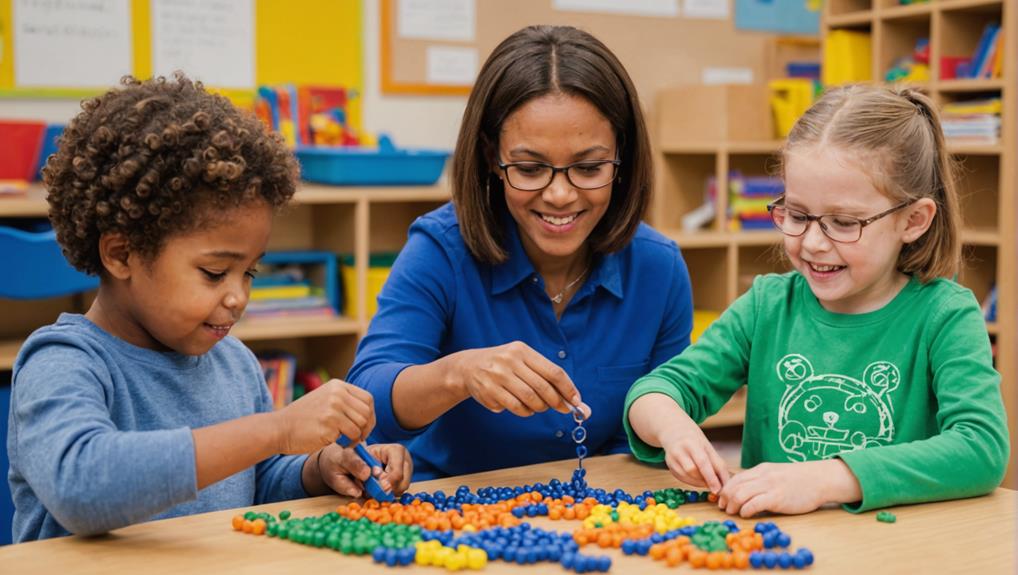
As children with developmental delays progress into kindergarten, it becomes increasingly vital to focus on enhancing their fine motor skills through targeted activities, a strategy proven effective in pediatric occupational therapy. This phase of Child Development is essential for strengthening such skills, which are foundational to tasks like writing, drawing, and using school supplies.
Implementing activities like tracing, cutting, and buttoning can significantly improve hand-eye coordination and finger dexterity. These activities engage children with their environment and foster their ability to manipulate it with greater control and precision, a fundamental aspect of developmental milestones.
Supplementing this with arts and crafts projects and play sessions with building blocks can further enhance fine motor skill development. These activities provide a creative and engaging platform for children to practice their skills repeatedly, promoting progress.
Benefits of Skill Development
The positive impacts of improving fine motor skills among children with developmental delays are manifold and significant. Early intervention, such as occupational therapy, can play a pivotal role in helping children reach their developmental milestones, including fine motor skills. Specifically, they can increase academic performance, foster greater independence in daily tasks, and enhance self-confidence. In the following sections, we will investigate these benefits in more detail, shedding light on the profound implications of improving fine motor skills in these children.
Enhancing Academic Performance
Nurturing fine motor skills in children with developmental delays can significantly improve their academic performance and handwriting proficiency. Fine motor skills enable children to participate in essential academic tasks such as writing, drawing, and using tools effectively. Improving these skills can promote increased involvement in classroom activities, self-assurance, and educational outcomes.
The advantages of enhancing fine motor skills in children with developmental delays are numerous:
- Improved handwriting: Better command over small muscle movements can improve writing skills.
- Active participation: Children with well-developed fine motor skills are more likely to engage in classroom activities actively.
- Increased confidence: Mastery of fine motor skills can instill confidence and promote participation.
- Improved cognitive abilities: Fine motor skill development can positively influence cognitive abilities and problem-solving skills.
- Overall academic success: Children who enhance their fine motor skills often demonstrate higher academic performance.
Building Independence
One cannot underestimate the influential impact of fine motor skill development in fostering independence among children with developmental delays. As these essential skills improve, they equip children to perform daily activities such as dressing and feeding independently. This newfound autonomy boosts their self-esteem and promotes participation in school and social activities.
Therefore, interventions to help develop these skills are crucial for the child’s overall growth. Each child needs a tailored approach that considers their distinct strengths and areas of improvement. Strengthening fine motor skills can increase opportunities for children to engage in age-appropriate tasks and interactions, nurturing a sense of belonging.
Moreover, it’s essential to note that building independence through fine motor skill development is a gradual process, requiring patience and perseverance from both caregivers and children. As these skills develop, children become more confident and enthusiastic to explore their environment, promoting further development.
Boosting Self-Confidence
As we further explore the impact of pleasing motor skill progression in children with developmental delays, it’s crucial to highlight its role in boosting self-assurance. The progression of these skills fosters independence, leading to a rise in self-esteem as children master small parts of their world.
- Developing fine motor skills aids children in becoming more self-reliant in daily tasks, reinforcing a sense of accomplishment and empowering confidence.
- Improved fine motor skills and increased self-esteem foster mastery of overdressing, eating, and writing.
- Pleasing motor skill progression enables fuller participation in school activities and social interactions, enriching self-assurance.
- Building these skills can reduce frustration experienced by children with developmental delays, further empowering their self-confidence.
- Enhanced fine motor skills widen the range of activities children can engage in, fostering a positive self-image and a sense of capability.
Incorporating strategies to develop fine motor skills in children with developmental delays is not merely about physical development. It is also about nurturing their self-confidence, enabling them to engage more fully in their world, and enriching their quality of life.
Sticker Activities for Coordination
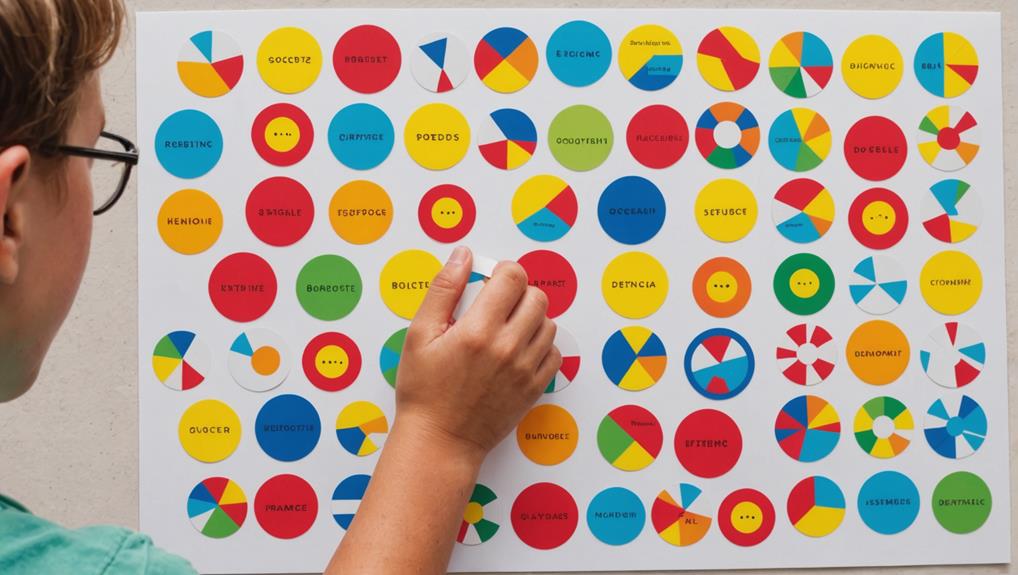
Sticker activities offer a versatile approach to enhancing fine motor skills in children with developmental delays. These simple yet effective exercises improve hand-eye coordination, pincer grasp, and finger dexterity while driving children’s focus and engagement. In the upcoming discussion, we will delve into different sticker placement techniques and the corresponding benefits they confer in the context of coordination improvement.
Sticker Placement Techniques
Using sticker placement methods provides a creative and effective strategy for enriching fine motor skills in children with developmental delays. These activities are enjoyable and vital in promoting the development of the pincer grasp, a critical fine motor skill.
Sticker placement methods offer numerous benefits for children with developmental delays:
- They involve placing stickers on a child’s hands or clothing for them to peel off, thereby enriching fine motor coordination.
- They help develop the pincer grasp and visual motor coordination skills necessary for fine motor control.
- Drawing open circles on paper for the child to place stickers can improve hand-eye coordination and precision.
- Sticker activities are engaging and effective in promoting finger dexterity and are essential for improving fine motor skills.
- By incorporating sticker placement methods, children can practice crucial fine motor skills while having fun and building confidence.
Through these approaches, we can help children with developmental delays enrich their fine motor abilities meaningfully and enjoyable.
Benefits of Sticker Activities
Sticker activities can improve fine motor skills and coordination in children with developmental delays. These engaging and interactive activities are powerful tools to boost a child’s hand-eye coordination and the fine motor skills needed in daily life tasks.
The physical act of peeling off a sticker involves the pincer grasp, a substantial fine motor skill. As children’s hands navigate the process, they unknowingly work on finger dexterity and hand control. This simple yet effective activity promotes precision, a fundamental element in developing fine motor skills.
Moreover, placing stickers in predetermined areas, like open circles on paper, encourages concentration and coordination. The fun and enjoyment derived from the activity can motivate the child to repeat the task, leading to consistent practice and improvement.
Sticker activities can also be adapted to match different skill levels, offering a tailored approach to learning. This provides a sensory experience beneficial to children with developmental delays. The benefits of sticker activities, therefore, extend beyond just fun. They offer a nurturing environment for developing fine motor skills and coordination.
Stringing Activities: Building Dexterity
Motor skill-building threading exercises are powerful tools for enhancing children’s fine motor abilities, especially for those with developmental delays. This activity involves threading beads or objects onto a string or pipe cleaner, improving hand-eye coordination and finger dexterity. It offers a fun, interactive way for children to work on their fine motor skills and build strength.
Threading exercises are beneficial in several ways:
- They help strengthen fine motor skills, enhancing the child’s ability to manipulate small objects.
- They promote bilateral coordination as children use both hands to control the string and beads.
- These activities aid in developing the pincer grasp, which is essential for tasks like holding a pencil or using utensils.
- The interaction and engagement threading exercises provide can help maintain a child’s interest, making skill-building more enjoyable.
- Lastly, they offer an opportunity to build hand strength and agility, significant components of fine motor skills.
With compassionate guidance, these exercises can improve coordination and agility for children with developmental delays.
Paper Activities: Enhancing Strength
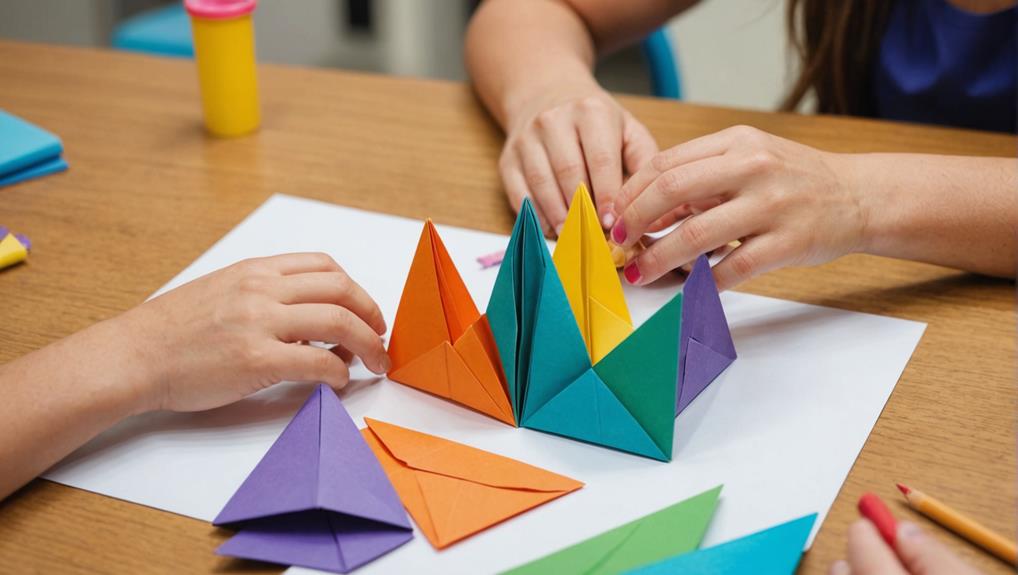
Paper activities provide a multifaceted approach to enhancing strength and coordination in children with developmental delays. Simple tasks such as ripping, crumpling, or folding paper can effectively develop hand muscles and foster fine motor skills. It’s essential to understand the benefits of these activities, the variety of paper exercises available, and how to monitor progress effectively through these tasks.
Benefits of Paper Activities
Why not consider paper activities’ humble yet potent power in developing fine motor skills in children with developmental delays? Paper activities, such as tearing or crumpling paper, offer various benefits to improve a child’s hand strength and coordination.
Consider these key advantages:
- These activities help fortify hand muscles. This is vital for tasks that demand fine motor skills, such as writing or drawing.
- They encourage the bimanual tripod grasp, a necessary grip used in everyday tasks.
- Paper activities improve hand strength and coordination, preparing children for more advanced fine motor skills.
- They enhance hand-eye coordination and precision in manipulating objects. This is crucial for their overall motor development.
- Paper activities can also be enjoyable and engaging, allowing children to enhance muscle strength and agility.
Incorporating these simple yet effective paper activities can be beneficial for serving children with developmental delays. They may appear understated, but they hold great potential in boosting fine motor skills and hand strength, paving the way for children’s success in performing routine tasks.
Types of Paper Exercises
Engaging in various paper exercises is a potent way to enrich fine motor skills in children with developmental delays. One such exercise is tearing or crumpling paper, strengthening hand muscles, and promoting a bimanual tripod grasp. This simple activity builds muscle endurance while enhancing the child’s hand-eye coordination and finger dexterity.
Another effective paper exercise is creating mosaic crafts by tearing paper. This task improves bilateral integration and fine motor control and serves as a creative outlet for the child. Through this, they can learn to manipulate and control small pieces of paper, refining their fine motor skills.
Furthermore, cutting and gluing activities with paper can be valuable for skill development. These activities help enhance spatial awareness, hand strength, and precision. The critical advantage of paper exercises is their versatility. They can be tailored to different skill levels, providing a supportive platform for fine motor skill development.
Monitoring Progress Through Activities
In therapeutic interventions, paper activities are essential for improving and measuring the progress of fine motor skills in children with developmental delays. These activities to develop strength and agility offer a distinct and engaging way to monitor progress over time.
Incorporating paper activities such as tearing, crumpling, or folding paper provides tangible ways to measure strength and coordination improvements. This is achieved through:
- Boosting hand and finger strength, which is vital for daily tasks
- Fostering the bimanual tripod grasp, a fundamental skill for fine motor control
- Building overall agility and coordination directly impacts a child’s self-sufficiency
- Offering a sensory experience that engages children in a tactile manner
- Enabling therapists to track improvements in hand strength and fine motor skill development
Through compassion and understanding, we can use these therapeutic interventions to truly make a difference in the lives of children with developmental delays. By monitoring progress, we can celebrate each small victory, encouraging children to continue their efforts and enjoy the results of their hard work.
Coin Activities: Encouraging Precision
Promoting fine motor skills and precision in children with developmental delays can be an engaging and rewarding experience through coin activities. These hands-on tasks involve children placing coins in a piggy bank. This simple but effective activity stimulates the development of pincer grasp and visual motor coordination, crucial skills for everyday tasks.
Sorting and stacking coins can introduce further challenges, demanding precision and developing hand and finger strength. By adjusting the complexity of these tasks, care providers can tailor coin activities to match different skill levels, providing a progressive and rewarding learning experience.
Coin activities allow children to improve their hand-eye coordination and precision in a fun and interactive manner. The tangible nature of the tasks, coupled with the familiar objects used, may increase the child’s engagement and motivation. More significantly, these activities enable children with developmental delays, fostering their independence and enhancing their self-confidence. Remember, every small step forward counts, and every coin placed correctly is a victory for improved motor skills.
Clothespin Activities: Boosting Creativity
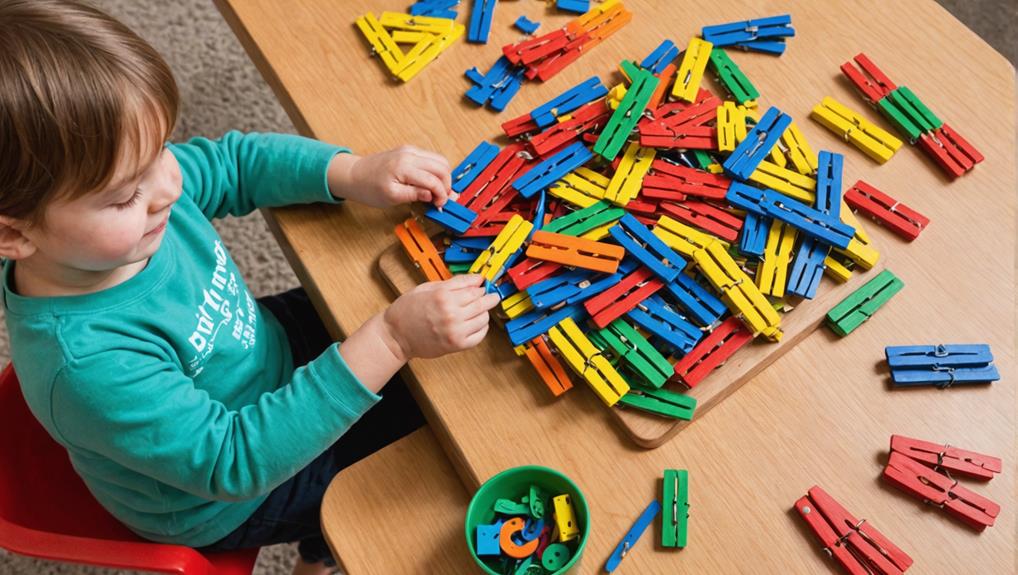
Clothespin activities are an effective tool for enhancing creativity and improving fine motor skills in children with developmental delays. These interactive exercises strengthen hand-eye coordination and finger strength and stimulate cognitive development. In the following discussion, we will investigate the benefits of clothespin use and suggest engaging exercises to promote motor skill development and creativity.
Clothespin Use Benefits
Using the simple clothespin in different activities can significantly improve the fine motor skills of children with developmental delays. Pinching and manipulating a clothespin requires strength, precision, and coordination, providing ample opportunity for children to hone these essential skills. Additionally, clothespin activities can be incorporated into various creative projects, adding an element of fun and engagement to the learning process.
The benefits of clothespin activities are diverse and include:
- Development of the pincer grasp, a crucial skill for tasks like writing and self-care.
- Improvement in hand-eye coordination, which is essential for a child’s overall motor development.
- It enhances finger dexterity, which aids in performing tasks that require precision.
- Strengthening hand muscles is often overlooked but necessary for many daily activities.
- Promoting independence, as mastery of these skills, can lead to self-reliance in different tasks.
Clothespin activities, therefore, serve as a valuable tool in therapy sessions to improve fine motor skills. They offer a fun, cost-effective, and efficient way to assist children with developmental delays to progress toward enhanced motor function and independence.
Engaging Clothespin Exercises
Incorporating engaging exercises into a child’s routine can significantly contribute to their developmental progress, and clothespin activities are no exception. These exercises have proven effective in improving fine motor skills in children with developmental delays. They promote hand strength, precision grasp, and finger dexterity, critical components in a child’s ability to interact with the world around them.
Clothespin exercises are beneficial and can also be fun and creative. Attaching clothespins to board books or clothing boosts body awareness and independence and provides children with a playful and interactive learning experience. This active participation can stimulate creativity and make the learning process more enjoyable.
Sidewalk Chalk: Stimulating Creativity
Releasing the vibrant world of sidewalk chalk activities offers a delightful playtime experience and an effective tool for enhancing fine motor skills in children with developmental delays. Gripping and guiding chalk across a sidewalk canvas can be a powerful catalyst for the coordination of small muscles in a child’s hand, improving fine motor skills.
- Enhancement of Hand and Finger Strength: Grasping chalk to draw stimulates the small muscles in a child’s hand, promoting strength and agility.
- Coordination and Precision: Tracing shapes or drawing lines improves fine motor control and precision.
- Sensory-Motor Integration: Sidewalk chalk art provides sensory input that promotes sensory and motor skills integration.
- Creativity and Imagination: Drawing with chalk allows children to express their creativity, keeping them engaged and motivated.
- Fun and Engagement: The playfulness of chalk activities makes them an enjoyable way to practice motor skills.
As caregivers and educators, we aim to make skill-building an engaging and enjoyable experience. Incorporating sidewalk chalk activities can be a versatile and effective strategy for achieving that goal.
Threading and Lacing: Improving Muscle Memory
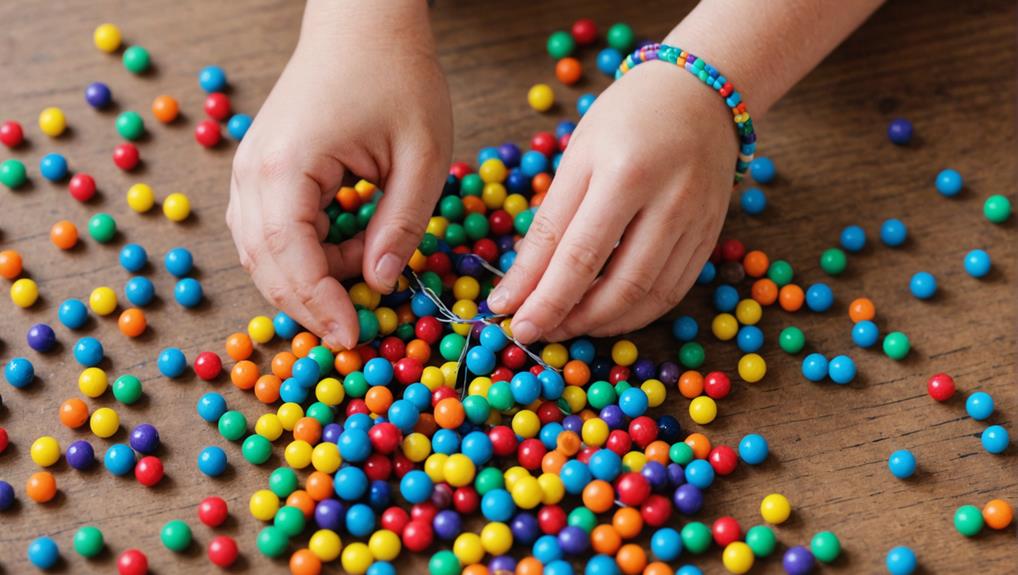
Frequently overlooked, threading and lacing activities improve muscle memory in children with developmental delays. These enriching exercises improve hand-eye coordination, fostering the development of fine motor skills and bilateral integration.
Children use laces through beads or Cheerios in these activities, precisely manipulating their fingers and hands. This strengthens their fine motor skills and promotes control and precision in their hand movements, which are crucial for daily tasks.
Children can progressively build their muscle memory and coordination by starting with larger beads and gradually progressing to smaller ones. This systematic approach allows them to master handling items of different sizes, enhancing their confidence and motivation in threading and lacing activities. This can support the overall development of fine motor skills in children with developmental delays. Therefore, parents and caregivers need to incorporate these activities into their daily routines, ensuring that each child has ample opportunity to practice and hone these critical skills.
Putty Activities: Strengthening Hands
Many putty activities can be powerful tools for strengthening hand muscles and improving grip and fine motor skills in children with developmental delays. These engaging and tactile methods allow children to improve their hand strength and coordination in a fun and interactive way.
Putty activities provide a variety of challenges that can help children with developmental delays sharpen their fine motor skills and boost their hand strength. These activities include:
- Sculpting shapes and objects: This encourages creativity while working on the strength and skill of the fingers and hands.
- Rolling balls: This activity helps enhance the child’s grip and finger coordination.
- Creating snakes: Rolling putty into long, thin shapes can help refine the child’s pinch skills.
- Hiding and finding objects: This can assist in developing problem-solving skills while also working on finger dexterity.
- Stretching and squeezing the putty can help improve overall hand strength and flexibility.
Incorporating putty activities into a child’s routine can offer a beneficial and enjoyable way to develop hand strength and fine motor skills.
Frequently Asked Questions
How Can I Help My Child With Fine Motor Delays?
Engage children with acceptable motor delays in activities like threading beads or scissors. Consult an occupational therapist for tailored plans. Use adaptive tools, celebrate progress, and encourage hand-eye coordination activities.
What strategies would you implement to help support fine motor skill development in infancy?
Introducing sensory toys of diverse textures and shapes stimulates exploration, while activities like stacking blocks and finger painting foster hand-eye coordination and fine motor skill development, which is crucial for children in their infancy stage.
What Are 3 Ways to Encourage Children’s Development in Small Motor Skills?
Activities such as threading beads, playing with puzzles or building blocks, and engaging in arts and crafts can encourage small motor skill development in children and improve hand-eye coordination and muscle strength.
Which Activity Helps Children Develop Fine Motor Skills?
Stringing activities, peg puzzles, and buttoning tasks significantly improve children’s fine motor skills by boosting finger dexterity, hand-eye coordination, and problem-solving abilities, aiding their comprehensive developmental progress.
Conclusion
To sum up, fostering fine motor skills in children with developmental delays is a critical endeavor that demands meticulous strategy. With the right blend of home activities, creative engagement, and occupational therapy, these children can experience a surge in skill and independence. As these tiny hands learn to master the world around them, the ripple effects can be seen in their immediate progress and long-term well-being, painting a brighter picture for their future.

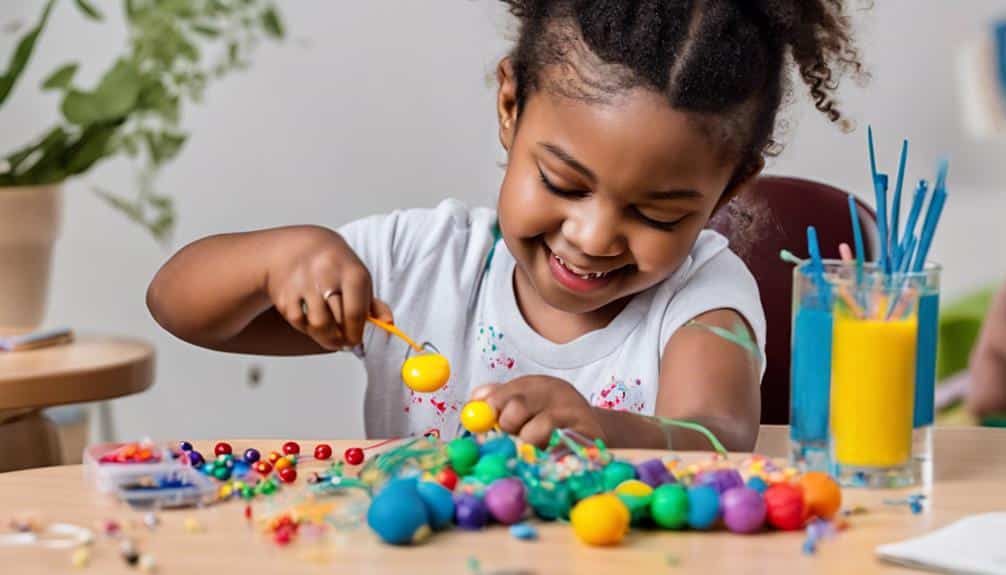
Recent Comments